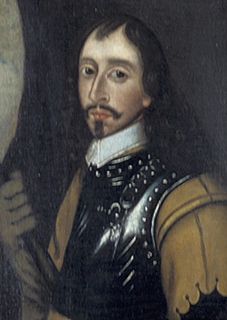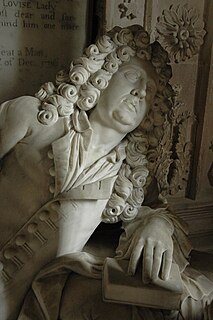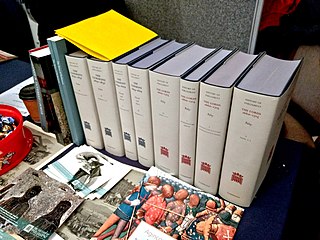Related Research Articles

George Monck, 1st Duke of Albemarle JP KG PC was an English soldier, who fought on both sides during the Wars of the Three Kingdoms. A prominent military figure under the Commonwealth, his support was crucial to the Restoration of Charles II in 1660, who rewarded him with the title Duke of Albemarle and other senior positions.

Sir Edward Massey was an English soldier and politician who sat in the House of Commons at various times between 1646 and 1674. He fought for the Parliamentary cause for the first and second English Civil Wars before changing allegiance and fighting for King Charles II during the Third Civil War. During the Interregnum, he was active for the Royalist cause. After the Restoration, he was knighted and was active in public life, as a member of parliament and occasionally in military and administrative affairs.
Lord William Powlett was an English Member of Parliament.
Middlesex was a constituency of the House of Commons of the Parliament of England, then of the Parliament of Great Britain from 1707 to 1800, then of the Parliament of the United Kingdom from 1801 until abolished in 1885. It returned two members per election by various voting systems including hustings.
Sir Samuel Luke sat in the House of Commons from 1640 to 1653 and in 1660, and was an officer in the Parliamentary army during the English Civil War.

Cockfield Hall in Yoxford in Suffolk, England is a Grade I listed private house standing in 76 acres (31 ha) of historic parkland, partly dating from the 16th century. Cockfield Hall takes its name from the Cokefeud Family, established there at the beginning of the 14th century. It was purchased by Jon Hunt in 2014 to form part of his Wilderness Reserve offering exclusive rural holiday accommodation.

Sir Job Charlton, 1st Baronet KS was an English judge and politician who sat in the House of Commons between 1659 and 1679. He was Speaker of the House of Commons of England briefly in 1673.

Sir Robert Atkyns, was a topographer, antiquary, and Member of Parliament. He is best known for his county history, The Ancient and Present State of Glostershire, published in 1712.
Hungerford Dunch was an English politician who sat in the House of Commons in 1660 and from 1679 to 1680.

Sir John Lenthall was an English Member of Parliament. He was elected MP for Gloucester in 1645, knighted by Oliver Cromwell in 1658 and made Governor of Windsor Castle from 1657 to 1660. After the 1660 Restoration of the Monarchy he was pricked Sheriff of Oxfordshire for 1672–73 and knighted a second time by Charles II in 1677.

The History of Parliament is a project to write a complete history of the United Kingdom Parliament and its predecessors, the Parliament of Great Britain and the Parliament of England. The history will principally consist of a prosopography, in which the history of an institution is told through the individual biographies of its members. After various amateur efforts the project was formally launched in 1940 and since 1951 has been funded by the Treasury. As of 2019, the volumes covering the House of Commons for the periods 1386–1421, 1509–1629, and 1660–1832 have been completed and published ; and the first five volumes covering the House of Lords from 1660-1715 have been published, with further work on the Commons and the Lords ongoing. In 2011 the completed sections were republished on the internet.
Samuel Gott was an English politician who sat in the House of Commons of England between 1645 and 1648 and between 1660 and 1661.

Sir Francis Wyndham, 1st Baronet of Trent in Somerset was an English soldier and politician who sat in the House of Commons of England in 1640. He was a colonel of horse in the Royalist army in the English Civil War and helped Charles II escape to France.
Samuel Browne was an English landowner and MP.
Sir William Wheler, 1st Baronet of the city of Westminster, was an English politician who sat in the House of Commons at various times between 1640 and 1660. He was knighted by the Lord Protector in 1657 and was made a baronet by King Charles II in 1660.
Sir Gilbert Gerard supported the Parliamentary cause in the English Civil War, held a number of positions during the Protectorate, sat in the House of Commons in the Convention Parliament of 1660, and was knighted shortly after the Restoration.
Richard Tolson (1622–1689) was an English lawyer and politician who sat in the House of Commons from 1646 to 1648 and in 1660.

The Board of Ordnance in the Kingdom of Ireland (1542–1800) performed the equivalent duties of the British Board of Ordnance: supplying arms and munitions, overseeing the Royal Irish Artillery and the Irish Engineers, and maintaining the fortifications in the island.
Roger James was an English landowner and politician who sat in the House of Commons at various times between 1661 and 1690.
The Honourable James Campbell of Burnbank and Boquhan was a Scottish nobleman of Clan Campbell. He was an officer of the Royal Scots Army and then the British Army, and a politician who sat in the Parliament of Scotland from 1699 to 1702 and as a Whig in the British House of Commons from 1708 to 1710.
References
- ↑ M. W. Helms and Leonard Naylor, CLARGES, Thomas (c.1618-95), of Westminster and Stoke Poges, Bucks. in The History of Parliament: the House of Commons 1660-1690 (1983). Online version accessed 9 August 2014.
- ↑ M. W. Helms and John. P. Ferris, KNIGHT, Ralph (c.1619-91), of Langold, Yorks. and Langwith, Notts. in The History of Parliament: the House of Commons 1660-1690 (1983). Online version accessed 9 August 2014.